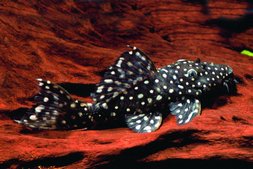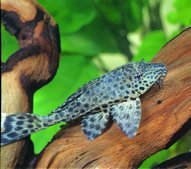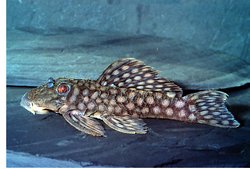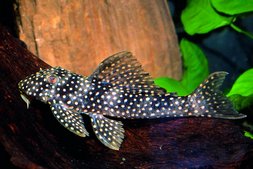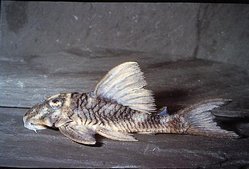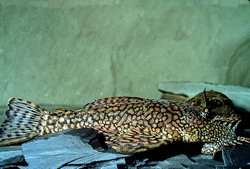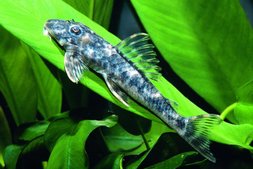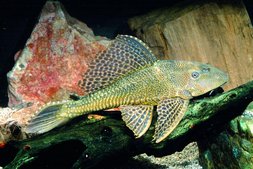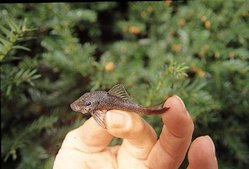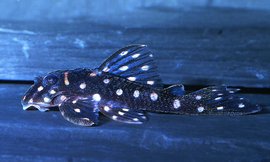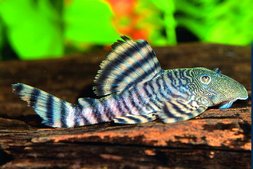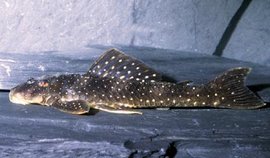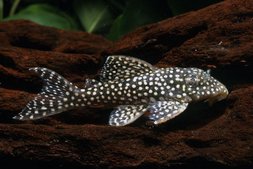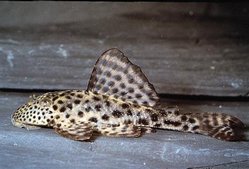Suckermouth Catfishes
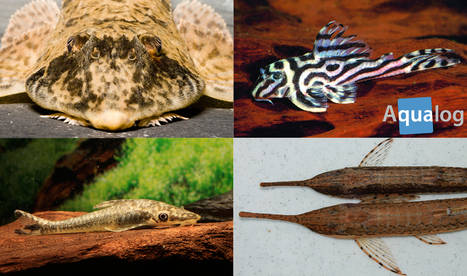
The suckermouth catfishes (Loricariidae) are the most species-rich family of all the catfishes. So far around 1,000 species have been scientifically described in 106 genera, with about 890 species currently regarded as valid. Many species that haven’t yet been scientifically described are available in the aquarium hobby and known by L- or LDA-numbers. Some species are very small, e.g. Parotocinclus longirostris, which grows to only around 1.5 cm long , but there are also species that attain almost a metre long, e.g. Acanthicus hystrix.
Suckermouth catfishes – which are also known as armoured catfishes, loricariids, or plecos – live in South and Central America. They have a sucker-like mouth (hence the name) and a body enclosed in bony armour. Many species are very popular in the aquarium hobby as algae-eaters (Ancistrus, Hypostomus, Otocinclus), others because of their bizarre body shapes (Loricaria, Rineloricaria, Farlowella) or attractive coloration (Hypancistrus, Peckoltia, Pseudacanthicus) or splendid finnage (Glyptoperichthys).
All suckermouth catfishes have teeth whose form reflects their dietary preferences: there are species that feed only on algae (cushion-like areas of fine teeth), omnivores (relatively broad areas of teeth), wood-eaters (spatulate teeth), and carnivores (hooked teeth). All suckermouth catfishes breed by laying eggs. Some species (e.g. Otocinclus) don’t practise brood care of any kind; others lay their eggs on solid substrates, where they are then tended by the male (e.g. Sturisoma, Farlowella, Hypoptopoma); in some species that live on sandy bottoms the lower lip of the male becomes enlarged at breeding time, and he uses it to carry the eggs around with him in a cluster until the young hatch (e.g. Pseudohemiodon, Loricaria, Hemiodontichthys); but the majority of species are cave-brooders, with the male guarding the spawn until the young hatch.
Important requirements
The chief variables in the maintenance of suckermouth catfishes are the water temperature, the diet (see below) and eventual size, so please note down these three species-specific parameters from the label on the sales aquarium.
In general, species from southern South America require a cool period (“winter”) of 14-16 °C, and 22-28 °C the rest of the time, while species from the Rio Negro or Rio Xingu, for example, require year-round temperatures between 26 and 30 °C.
The chemical composition of the water is of secondary importance, except for breeding. A pH between 6.0 and 8.3 and a total hardness between 5 and 20 °dGH will suit all species for long-term maintenance.
Appropriate feeding
Algae-eaters can be fed without problem in the aquarium using flake, food tablets, and occasional frozen foods. In addition they should regularly be given vegetable food in the form of slices of cucumber and dead leaves (Sea Almond, Walnut, Beech, Oak, Birch, Maple, etc). It is important for these fishes to have a diet rich in roughage but low in fat and protein. Omnivores can be fed the same basic diet but with an increased amount of frozen food, and occasional feeds of protein-rich granules should be given as well. Wood-eaters should always have soft bogwood available as the basis of their diet, but can otherwise be fed in the same way as algae-eaters. For carnivores the main elements of the diet should be frozen foods, granules, and food tablets. All suckermouth catfishes enjoy frozen peas, which should be thawed before use and gently squashed between the fingers.
Correct maintenance
As with all fishes, the most important element of maintenance is regular partial water changes, refilling with conditioned water. At least 25% of the tank volume should be changed every 14 days, and a weekly water change of the same amount is better. A larger water change, even at short intervals, will do no harm, but isn’t absolutely necessary. There will be no problems and no danger to the fishes if – for example during holidays – the partial water changes are suspended for 6-8 weeks, after which the regular water changes should be resumed. All suckermouth catfishes like current, so a powerful filter (turnover rate 2-4 times tank volume per hour is beneficial.
In the case of delicate species there should always be secondary plant material (humic acids, etc) in the aquarium; peat filtration, alder cones, or dead beech leaves can be used, or special liquid preparations added at every water change.
Aquarium and tankmates
Suckermouth catfishes are not active swimmers and have only a comparatively small urge to move around. They are substrate-oriented and virtually never swim in the open water (the only exception is the genus Rhinelepis, which is very rarely maintained in the aquarium). For this reason the aquarium size can be relatively small: around 5 times the eventual size of the fish long and 2-4 times wide. The depth of the tank is unimportant.
For the majority of species (Ancistrus, Hypostomus, L-number catfishes) the aquarium should contain plenty of hiding-places with a cave of suitable size for each individual. Suitable decor includes rocks, bogwood, and specially designed ceramic pipes. The majority of suckermouth catfishes of this group defend a small Individual territory where conspecifics are not tolerated, but can nevertheless characterised as fundamentally peaceful. Only large specimens of Acanthicus and Pseudacanthicus (cactus catfishes) are relatively aggressive, but again the aggression is aimed at conspecifics, in part because of their comparatively poor swimming ability. But a word of warning: if large suckermouth catfishes and freshwater stingrays are housed together then in some situations the rays can be seriously injured by the catfishes.
The majority of Loricaria, Hemiodon, Pseudohemiodon, Spatuloricaria, etc require specially decorated aquaria. These species live on sandy bottoms and require the largest possible bottom area with a fine sandy substrate and only sparing decor otherwise. Smaller members of the group (Rineloricaria, Hemiloricaria) also require breeding caves.
A third ecological group, comprising the dwarf suckermouths (Otocinclus, etc), the twig catfishes (Farlowella), and the whiptail cats (Sturisoma and related genera), should be kept in well-planted aquaria. These species do not require caves.
Life expectancy
All suckermouth catfishes are long-lived fishes: the small species (Otocinclus) can live for several years, and large ones even for decades.
Size
The majority of species of suckermouth catfishes grow relatively slowly. Small species are usually full-grown after a year, medium-sized (8-15 cm) after two years. The growth rate of larger (30-40 cm) species in the aquarium depends very much on the availability of food and space, with most of these species likewise attaining their eventual size in their second or third year of life.
Special details
Suckermouth catfishes (labelled “L-catfishes”) are currently the “in” fishes in the aquarium hobby, and very many species, local variants, individual variants, and cultivated forms are seen on the market. Please check out the label on the sales aquarium for the potential eventual size and special details of any fishes that interest you.





